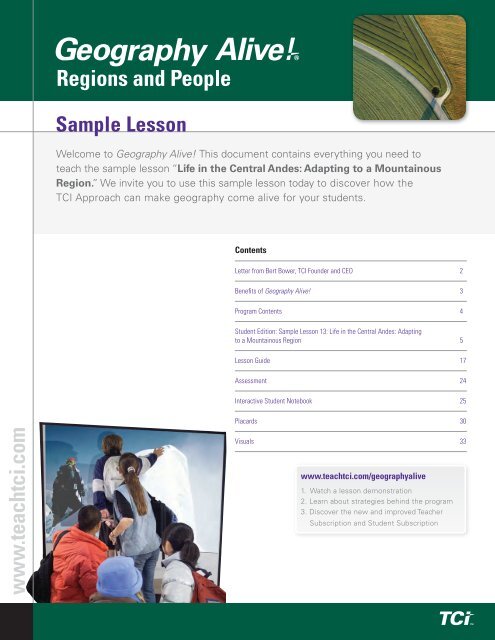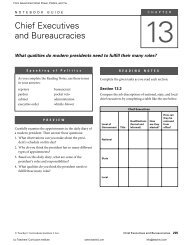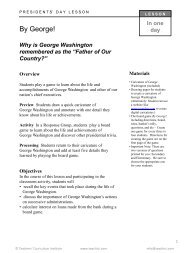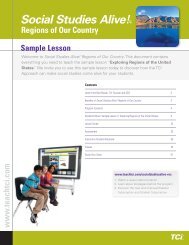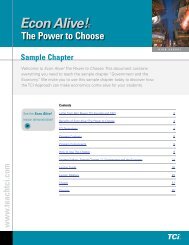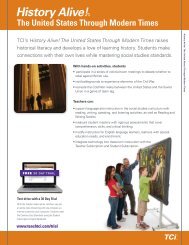Geography Alive! Regions and People | Sample Chapter ... - TCI
Geography Alive! Regions and People | Sample Chapter ... - TCI
Geography Alive! Regions and People | Sample Chapter ... - TCI
You also want an ePaper? Increase the reach of your titles
YUMPU automatically turns print PDFs into web optimized ePapers that Google loves.
Welcome!<strong>Geography</strong> <strong>Alive</strong>! <strong>Regions</strong> <strong>and</strong> <strong>People</strong>Welcome to the second edition of <strong>Geography</strong> <strong>Alive</strong>! <strong>Regions</strong> <strong>and</strong> <strong>People</strong>.Since the program first was released, I’ve been snapping photos of mystudents in action at Mission High School in San Francisco Unified <strong>and</strong> askingother teachers to send me photos of their students using the program as well.Despite the great diversity of classes in which the images were taken—in bothmiddle <strong>and</strong> high school classes, in urban <strong>and</strong> suburban settings, in mainstream<strong>and</strong> English Language Development classes—one similarity always strikes me:students are actively involved in geography <strong>and</strong> having a great time.welcomeTogether we willcreatively challengestudents to use thetools of geographyto view, analyze, <strong>and</strong>underst<strong>and</strong> the worldaround them.Our goal in creating <strong>Geography</strong> <strong>Alive</strong>! was to rescue the study of geography froma mind‐numbing, encyclopedic romp around the globe. So we created an engaging,case‐study approach worthy of the high st<strong>and</strong>ards set by the professionalgeographers at the National Council for Geographic Education. Each activity notonly aligns with the National <strong>Geography</strong> St<strong>and</strong>ards, but is framed by an EssentialQuestion <strong>and</strong> built around an interactive classroom activity.I encourage you to try this sample lesson from <strong>Geography</strong> <strong>Alive</strong>! with yourstudents today. And I’d love one day to receive a photo of your students in action,totally absorbed in the study of geography, <strong>and</strong> to welcome you to the growing<strong>TCI</strong> community of inspired, active social studies teachers.Best,Bert Bower<strong>TCI</strong> Founder <strong>and</strong> CEO2
Program ContentsUnit 3: Latin America9 Spatial Inequality in MexicoCity: From Cardboard to Castles10 Indigenous Cultures: TheSurvival of the Maya ofMesoamerica11 Dealing with Extreme Weather:Hurricanes in the CaribbeanUnit 7: Monsoon Asia27 Waiting for the Rains: TheEffects of Monsoons inSouth Asia28 Tech Workers <strong>and</strong> Time Zones:India’s Comparative Advantage29 Mount Everest: Climbing theWorld’s Tallest Physical Feature<strong>Geography</strong> <strong>Alive</strong>! <strong>Regions</strong> <strong>and</strong> <strong>People</strong>12 L<strong>and</strong> Use Conflict in theAmazon Rainforest30 China: The World’s MostPopulous CountryIn <strong>Geography</strong> <strong>Alive</strong>! <strong>Regions</strong> <strong>and</strong><strong>People</strong>, an Essential Questionorganizes each lesson <strong>and</strong> its correspondingactivity. By reading theStudent Edition <strong>and</strong> participatingin the classroom activity, studentsgain a deeper underst<strong>and</strong>ing ofthe content.13 Life in the Central Andes:Adapting to a MountainousRegionUnit 4: Europe <strong>and</strong> Russia14 Supranational Cooperation inthe European Union15 Population Dilemmas in Europe16 Invisible Borders: TransboundaryPollution in Europe31 Population Density in Japan:Life in a Crowded Country32 The Global Sneaker: From Asiato EverywhereUnit 8: Oceania <strong>and</strong> Antarctica33 Relative <strong>and</strong> Absolute Location:What Makes Australia Unique?34 The Pacific Isl<strong>and</strong>s: Adapting toLife Surrounded by Ocean<strong>Sample</strong> Lesson:13 Life in the Central Andes:Adapting to a MountainousRegion17 Russia’s Varied L<strong>and</strong>scape:Physical Processes at Work18 New Nation-States from theOld Soviet Empire: Will TheySucceed?35 Antarctica: Researching ClimateChange at the Coldest Placeon EarthUnit 5: AfricaUnit 1: The Geographer’s World1 The Tools of <strong>Geography</strong>2 A Spatial Way of Thinking19 The Nile River: A Journeyfrom Source to Mouth20 Life in the Sahara <strong>and</strong> the Sahel:Adapting to a Desert RegionUnit 2: Canada <strong>and</strong> the United States3 Settlement Patterns <strong>and</strong> Waysof Life in Canada4 The Great Lakes: The U.S. <strong>and</strong>Canada’s Freshwater Treasures5 Urban Sprawl in North America:Where Will It End?21 Micro-entrepreneurs:Women’s Role in the Developmentof Africa22 Nigeria: A Country of ManyCultures23 Resources <strong>and</strong> Power inPost-apartheid South AfricaFREE 30 DAY TRIALcontents6 National Parks: Saving the NaturalHeritage of the U.S. <strong>and</strong> Canada7 Consumption Patterns in theUnited States: The Impact ofLiving Well8 Migration to the United States:The Impact on <strong>People</strong> <strong>and</strong>PlacesUnit 6: Southwest <strong>and</strong> Central Asia24 Oil in Southwest Asia: How“Black Gold” Has Shapeda Region25 Istanbul: A Primate CityThroughout History26 The Aral Sea: Central Asia’sShrinking Water SourceTest-drive with a 30 Day TrialWith the Teacher Subscription, teachers can get anentire class interacting with one computer, an internetconnection <strong>and</strong> a projector. Students thrive on theimmediate feedback they get using the StudentSubscription’s Reading Challenges.www.teachtci.com/trial4
Life in the CentralAndes: Adapting to aMountainous Region13.1 IntroductionLa Paz, Bolivia, is the highest big city in the world, sitting at 12,000 feet abovesea level in the central Andes Mountains of South America. This high elevationcan produce some odd effects. Golfers in La Paz can hit a golf ball muchfarther than they can at sea level. At a nearby ski resort, a skier may need towear an oxygen tank to go skiing.These effects are the result of thin air. The air is thinner at high elevationsbecause the force of gravity pulls air downward, which means that there is lessoxygen in the air at high elevations. This is why the skier in La Paz requiresan oxygen tank. The thin air is also the reason a golf ball will travel farther at12,000 feet. At that elevation, there is less air to cause friction on the ball <strong>and</strong>slow it down.The people of La Paz are accustomed to living at high elevations. Likeall of the people who live in the Andes Mountains, they have had to adapt tothe effects of high elevation. The Andes include some of the highest mountainpeaks in the world, with many of them rising much higher than La Paz. Thevarious elevation levels in these mountains influence the way people live.In this chapter, you will read about life in the central Andes. You willalso learn about altitudinal zonation, a term that refers to the division ofmountainous l<strong>and</strong> into zones based on altitudes, or elevations. You will findout about the four main elevation zones in the Andes <strong>and</strong> how the peopleliving there have adapted to each zone.CHAPTER13| Student Edition | Lesson Guide | Lesson Masters | Interactive Student Notebook | Placards | Visuals6Essential QuestionGraphic OrganizerHow do people adapt to livingin a mountainous region?This diagram represents theAndes Mountains of SouthAmerica. Notice that themountain is divided into fourzones based on elevation.Each zone has its own rangeof temperatures. It also has itsown distinct plant <strong>and</strong> animallife. The features of each zoneinfluence how people live. Thinkabout this diagram as you try toanswer the Essential Question.Tierra Helada20°F–55°FTierra Fría55°F–65°FTierra Templada65°F–75°FTierra Caliente75°F–80°FElevation12,000–15,000 feet6,000–12,000 feet3,000–6,000 feet0–3,000 feet▲A mountain valley <strong>and</strong> snow-covered volcano in Ecuador191
A Mountain CityLa Paz, Bolivia, is the highest big cityin the world. It is located at 12,000 feetin the heart of the Andes Mountains.The Andes run the length of SouthAmerica. The only higher mountainsin the world are the Himalayas ofAsia. The people of the Andes havehad to adapt to life at high elevations.13.2 The Geographic SettingSouth America, the world’s fourth largest continent, encompasses 12countries <strong>and</strong> a wide range of environments. The continent has deserts,tropical rainforests, <strong>and</strong> several mountain ranges, with the greatestmountains being the Andes.The Andes: Backbone of South America The Andes consist ofseveral mountain ranges that are known in Spanish as cordilleras. Thesecordilleras form the longest chain of high mountains on Earth, stretchingfor approximately 4,500 miles from north to south, along the westcoast of South America. The Andes have appropriately been nicknamedthe backbone of South America.The Andes Mountains pass through seven countries, featuring manydifferent l<strong>and</strong>scapes along the way. Some parts of the Andes are coveredwith dense forest, whereas other regions are rocky <strong>and</strong> bare. More than50 mountains within the Andes reach elevations of more than 20,000feet. These lofty peaks are always covered with snow <strong>and</strong> ice.The Andes can be grouped in three sections. The northern Andescross Venezuela <strong>and</strong> Colombia. The southern Andes run through Chile<strong>and</strong> Argentina. The central Andes cover Ecuador, Peru, <strong>and</strong> Bolivia. Thischapter focuses on the central Andes.The Four Elevation Zones of the Andes In the introduction, youread about altitudinal zonation, learning that there are four main elevationzones in the Andes. These elevation zones are also called climatezones because elevation helps determine climate. The four elevationzones are illustrated in the diagram on the next page.The elevation zones in the Andes are known by their Spanish names.The lowest zone is called tierra caliente, or hot country. Above that is azone known as tierra templada, or cool country. Next comes tierra fría,or cold country. The highest elevation zone is known as tierra helada,which means frost country.The link between climate <strong>and</strong> elevation is based on two factors. Thefirst factor is solar energy, which is the heat <strong>and</strong> light emitted by thesun. This energy from the sun warms Earth’s surface. Some solar energyis also reflected by Earth back into the atmosphere, with the air closestto the surface absorbing most of the reflected heat.The second factor is the force of gravity. Gravity pulls air in theatmosphere down toward Earth. As a result of this process, the airbecomes denser at lower elevations. The denser the air, the more heat itcan absorb. As you move higher, the air becomes thinner <strong>and</strong> holds lessheat. For every 1,000-foot rise in elevation, the temperature of the airdrops by around 3.5°F.The higher you go in the Andes Mountains, the cooler the temperaturebecomes. This is true even in regions that are near the equator. Forexample, both of Ecuador’s two largest cities, Guayaquil <strong>and</strong> Quito, lienear the equator. Guayaquil has an annual average temperature of 77°F,but Quito’s average temperature is much cooler, just 55°F. The reasonfor the difference is elevation. Guayaquil is located at sea level, whereasQuito sits at an elevation of 9,350 feet. One city lies in tierra caliente, theother in tierra fría.| Student Edition | Lesson Guide | Lesson Masters | Interactive Student Notebook | Placards | Visuals7192 <strong>Chapter</strong> 13
▲Geotermsaltitudinal zonation the division of l<strong>and</strong> into zonesbased on elevation, which in turn helps determine climate<strong>and</strong> vegetationsnow line the lowest elevation on mountains where snowremains year-roundterracing the creation of flat areas on mountain slopesfor the purpose of farmingtree line the highest elevation where trees grow on amountainvertical trade the trading of crops between lowl<strong>and</strong> <strong>and</strong>highl<strong>and</strong> areasTierra Helada20°F–55°FTierra Fría55°F–65°F| Student Edition | Lesson Guide | Lesson Masters | Interactive Student Notebook | Placards | Visuals8Tierra Templada65°F–75°FTierra Caliente75°F–80°FAltitudinal Zonation in the AndesThis diagram shows the four elevation zones of the Andes. Notice howthe climate cools the higher you go. That’s because the air gets thinner<strong>and</strong> holds less heat.Life in the Central Andes: Adapting to a Mountainous Region 193
Tierra Caliente75°F–80°FThe Tierra CalienteThe tierra caliente is the lowestelevation zone in the central Andes.Conditions here are tropical. <strong>People</strong>dress in light clothing <strong>and</strong> live inhouses open to the air. They alsohave to cope with tropical diseaseslike malaria.13.3 The Tropical Lowl<strong>and</strong>s: Tierra CalienteA worker is picking bananas on a plantation in Ecuador. The temperatureis high, so he stops frequently to wipe the sweat from his brow. He alsomust watch out for spiders because tarantulas often hide within bananastalks. A tarantula bite may not be deadly, but it is extremely painful.This banana plantation is located in the tierra caliente. Consistingmostly of tropical lowl<strong>and</strong>s, this elevation zone lies at the foot of theAndes on both the eastern <strong>and</strong> western sides. <strong>People</strong> who live in thetierra caliente must adapt to a hot year-round climate.Physical Characteristics The tierra caliente is the lowest of the fourelevation zones of the Andes, extending from sea level to approximately3,000 feet. The climate of this zone is generally hot <strong>and</strong> humid, with theaverage temperature ranging from 75°F to 80°F.Broadleaf evergreen forests cover the eastern slopes of the AndesMountains heading into the Amazon River basin. On the western slopesof the Andes, the natural vegetation ranges from lush rainforests totropical grassl<strong>and</strong>s.The Pacific coast of Peru is different. This area is also situated withinthe tropics, but it receives little rainfall. Here the l<strong>and</strong> is mostly desert.Great s<strong>and</strong> dunes rise up in some places, whereas other parts are flat <strong>and</strong>rocky. Where there is water from rivers or streams, however, the vegetationis tropical.| Student Edition | Lesson Guide | Lesson Masters | Interactive Student Notebook | Placards | Visuals9Banana PlantationBananas thrive in the tierra caliente.They are grown on large plantationslike this one. Many plantation workersare descended from Africansbrought to South America as slaves.194 <strong>Chapter</strong> 13
Tierra Fría55°F–65°FThe Tierra FríaThe tierra fría reaches elevations of12,000 feet. Many native peoples livein this zone. They have developedlarger lungs to take in more oxygenfrom the thin air at these heights. Fivehundred years ago, the centers of theInca Empire were located here.Market Day in PeruThe people at this market are wearingthe dress of highl<strong>and</strong> Indians. Highl<strong>and</strong>markets are centers of verticaltrade. Potatoes <strong>and</strong> wheat from thehighl<strong>and</strong>s are traded here for bananas<strong>and</strong> oranges from the lowl<strong>and</strong>s.13.5 The Cool Highl<strong>and</strong>s: Tierra FríaA woman rises early in the highl<strong>and</strong> city of Cuzco, Peru. This is tierrafría, <strong>and</strong> the morning air is cold. The woman puts on a warm sweater<strong>and</strong> shawl <strong>and</strong> heads off to the market to buy food, walking downancient stone streets built by her ancestors, the Incas. A light frost onthe stones makes them slippery, so she steps carefully. She is accustomedto life in the highl<strong>and</strong>s.Physical Characteristics Covering much of the central Andes Mountains,the tierra fría elevation zone lies between 6,000 <strong>and</strong> 12,000 feet.The average temperatures within this zone vary from 55°F to 65°F, butthe nights are colder. At higher elevations, the temperatures often dipbelow freezing.Mountains <strong>and</strong> valleys are the main physical features of the tierrafría elevation zone. The mountains are steep <strong>and</strong> rugged, but flat basins<strong>and</strong> plateaus can be found among the peaks.A high plateau called the Altiplano lies at an average elevation ofover 11,000 feet between Peru <strong>and</strong> Bolivia. This plateau contains LakeTiticaca, the world’s highest navigable lake. A navigable lake is one thatis large <strong>and</strong> deep enough for large boats. Lake Titicaca is rumored tohold hidden treasure, according to legends that say the Incas threw goldinto the lake to protect it from the Spanish invaders.Vegetation within the tierra fría depends partly on the amount ofrainfall. In some places, enough precipitation occurs to support denseforests of pines <strong>and</strong> other conifers. In other places the l<strong>and</strong> is so dry thatonly shrubs <strong>and</strong> grasses can survive there.Elevation is another factor that affects what grows where. The treeline in the central Andes lies between 10,000 <strong>and</strong> 12,000 feet. The treeline is the highest elevation at which trees will grow.Human Adaptations Approximately half the population of the centralAndes are indigenous peoples. Most of these people live in the tierra fría.The two main indigenous groups are the Quechua <strong>and</strong> the Aymara. Bothof these groups were once part of the mighty Inca Empire.Over the centuries, the native peoples of the Andes have adapted tolife at high elevations. They wear warm woolen clothes toprotect themselves from the cold. They also build thickwalledhouses out of stone or adobe brick. Even their bodieshave adapted to high elevations, as they have developedlarger lungs that can draw more oxygen from the thinmountain air.Farmers have adapted their practices to the highl<strong>and</strong>environment. They grow crops that do well at high elevations.These crops include potatoes, wheat, barley, corn,apples, <strong>and</strong> pears.Farmers also use terracing to carve fields out of steephillsides, building walls on the slopes <strong>and</strong> filling them inwith soil to create flat l<strong>and</strong> for planting. They irrigate theseterraces with mountain streams. This method of farminggoes back many centuries. The Incas used terracing to builda great civilization.| Student Edition | Lesson Guide | Lesson Masters | Interactive Student Notebook | Placards | Visuals11196 <strong>Chapter</strong> 13
Another sign of adaptation to life at high elevations is verticaltrade. This is the trade of farm products between the higher <strong>and</strong> lowerelevation zones of the Andes Mountains. Highl<strong>and</strong> farmers cannot growcrops from the lower zones, such as bananas, oranges, <strong>and</strong> tomatoes.Therefore, traders bring those products up to the highl<strong>and</strong> markets. Thetraders also take highl<strong>and</strong> crops, such as potatoes <strong>and</strong> wheat, down tothe lowl<strong>and</strong> markets. Through vertical trade, people who live in oneelevation zone can have access to foods grown in other elevation zones.In this way, they are able to achieve a more balanced <strong>and</strong> varied diet.Inca TerracesIn the 1400s, the Incas created anadvanced civilization in the Andes.These are the ruins of Machu Picchu,an Inca city in Peru. Notice the terracedfields at the edge of the city.| Student Edition | Lesson Guide | Lesson Masters | Interactive Student Notebook | Placards | Visuals12Making Freeze-Dried PotatoesLong ago, Indians in the high Andes learned how to make chuño,or freeze-dried potatoes. They leave the potatoes out in the coldnight air to freeze. The next day, they squeeze the water out of thethawing potatoes. They rinse them in the riverbed <strong>and</strong> then leavethem out to dry. Chuño can be stored for years without spoiling.Life in the Central Andes: Adapting to a Mountainous Region 197
Tierra Helada20°F–55°FThe Tierra HeladaThe tierra helada is the highest zoneof the central Andes. Conditions herecan be harsh. The climate is cold, <strong>and</strong>vegetation is sparse. <strong>People</strong> growhardy crops like quinoa, a grain thatis rich in protein. They also work inmines. The mines of Bolivia wereonce among the richest in the world.13.6 The Icy High Elevations: Tierra HeladaEvery year, many Quechua Indians hike to a shrine in the mountainshigh above the city of Cuzco. They travel there to worship the apus, ormountain gods. “We make offerings to the mountains,” says one pilgrim,“asking them to send water for our crops <strong>and</strong> livestock.”The shrine above Cuzco is set in the tierra helada, the highest elevationzone of the Andes. The pilgrims who make this journey have to becareful to walk slowly because the air is very thin. If people move tooquickly at this high elevation, they can experience altitude sickness froma lack of oxygen. Altitude sickness can cause headaches, fatigue, shortnessof breath, <strong>and</strong> nausea.Physical Characteristics The tierra helada lies between 12,000 <strong>and</strong>15,000 feet, with average temperatures varying from 20°F to 55°F. Thisis an extreme environment. The climate is very cold <strong>and</strong> windy. It oftenfreezes at night, <strong>and</strong> snow falls at the higher elevations. At the upperedge of this zone lies the snow line, which is the elevation at whichpermanent snow <strong>and</strong> ice begin. Above the snow line, snow remains onthe ground year-round.Most of the tierra helada lies above the tree line, which means thattrees are very rare in this elevation zone. The most common forms ofplant life are low-lying shrubs <strong>and</strong> hardy grasses, which are found inalpine meadows called paramos or punas.Human Adaptations The tierra helada is a challenging environmentfor humans, which is why relatively few people live at these extremeelevations. Most of the people who live here are indigenous peoples likethe Quechua <strong>and</strong> the Aymara.| Student Edition | Lesson Guide | Lesson Masters | Interactive Student Notebook | Placards | Visuals13Spinning WoolThese highl<strong>and</strong> women are spinningwool from an alpaca into yarn. Theyarn will then be woven into cloth.Alpaca wool is finer <strong>and</strong> straighterthan sheep wool. It is one of the bestfibers for making soft, warm garments.198 <strong>Chapter</strong> 13
<strong>People</strong> have adapted to life in the tierra helada in variousways. As in the tierra fría, they dress in warm clothing. Theyplant the few crops that will grow at high elevations, including anative grain called quinoa, along with certain types of potatoes.They also raise llamas <strong>and</strong> alpacas, two types of animals thatare related to the camel. Llamas <strong>and</strong> alpacas produce thick woolfor blankets, bags, <strong>and</strong> clothing. Llamas also make good packanimals for transporting heavy loads across the mountains.Some of the people who live in this elevation zone work inmines. The high Andes have many mineral deposits, includingtin, lead, copper, <strong>and</strong> silver. Working conditions in the minesare quite dangerous, with many miners contracting lung diseaseor getting injured on the job. However, mining does provide oneof the few sources of cash income in this harsh environment.Above the Snow Line The highest part of the Andes lies justabove the tierra helada. This area extends from the snow line tothe tops of the tallest mountain peaks. In this cold <strong>and</strong> rockyregion, snow <strong>and</strong> ice cover much of the l<strong>and</strong>.This part of the Andes is generally not inhabited, but it stillplays a key role in Andean life. The reason is glaciers. Theselarge ice fields cover the highest peaks in the Andes, storinglarge amounts of water above the snow line. In the summer,water from melting glaciers flows down to people living at lowerelevations. Streams fed by these glaciers form a crucial part ofthe water supply.Glaciers are very sensitive to changes in climate. They can grow orshrink, depending on the changes in temperature <strong>and</strong> precipitation thatoccur over time. If glaciers melt too fast, the result can be disastrousfor the people who are living below them. “Glaciers don’t always behavenicely,” said a scientist who studies them. “Some glaciers have a nastyhabit of storing up large amounts of water <strong>and</strong> then releasing it suddenlyin a massive melt…which may involve floods, l<strong>and</strong>slides, or avalanches.”Shrinking Andes GlaciersThis satellite image shows a shrinkingglacier in the Andes. There isstill enough ice in this glacier to feedmountain streams year round. But ifthe glacier disappears, some of thosestreams may run dry part of the year.| Student Edition | Lesson Guide | Lesson Masters | Interactive Student Notebook | Placards | Visuals1413.7 Beginning to Think GloballyIn this chapter, you read about the four elevation zones in the centralAndes Mountains. Each of these elevation zones has its own climate<strong>and</strong> vegetation. You have also learned how people have adapted to theconditions in each zone.In other parts of the world, people have made different adaptationsto mountain living. In general, however, relatively few people in theworld live at high elevations because the conditions of life there are justtoo difficult.In the future, mountains may become more attractive to people asplaces to live. There are signs that the world’s climate is getting warmer,<strong>and</strong> if this warming trend continues, life will change at higher elevations.For example, tree lines <strong>and</strong> snow lines are likely to rise. As mountainsbecome warmer, more people may choose to live at higher elevations.At the same time, a warmer climate is likely to have a negative effecton mountain glaciers. Keep this in mind as you look at glaciers in thenext section.Life in the Central Andes: Adapting to a Mountainous Region 199
13.8 Global ConnectionsThe map to the right shows glaciersaround the world. There are about160,000 glaciers worldwide today.Some of these glaciers are found inlowl<strong>and</strong> cold areas such as Antarctica,whereas others have formed on highmountain peaks. Can you find examplesof both lowl<strong>and</strong> glaciers <strong>and</strong> mountainglaciers on the map?What is happening to mountainglaciers around the world? Manymountain glaciers are retreating, orshrinking. Look at the image of theGangotri Glacier on the next page, which isa mountain glacier that is located in theHimalayas. The lines on the photographshow how Gangotri Glacier has retreatedover time. Not all glaciers are shrinking,however. Some are staying the samesize or even exp<strong>and</strong>ing.Why are some mountain glaciersretreating? Most scientists blameclimate change for the shrinking ofglaciers. These scientists say that Earth’sclimate has been slowly warming. Theserising temperatures are causing glaciersto melt more than they have in the past.As their ice turns to water, the glaciersretreat.Glaciers Around the World, 20070°20°N20°S40°N40°STropic of CancerEquator60°NTropic of Capricorn60°SRocky Mountains80°NGlaciersIce sheets0 1,000 2,000 miles0 1,000 2,000 kilometersRobinson projection80°SGreat160°WNORTHAMERICAPlains160°W140°W140°W120°WSOUTHAMERICAA n d e s Mountains120°W100°W100°W80°WBrazilianHighl<strong>and</strong>sPampas80°W60°W60°W| Student Edition | Lesson Guide | Lesson Masters | Interactive Student Notebook | Placards | Visuals15What impact do retreatingglaciers have on people livingin mountainous regions?Approximately 75 percent of the world’sfresh water is frozen inside glaciers.When glaciers melt, they provide waterfor people to use. For example, the glaciersnear Quito, Ecuador, supply about80 percent of this South American city’swater. If Quito’s glaciers continue toshrink, they will provide less <strong>and</strong> lesswater to the city. “It’s kind of like abank account,” said one scientist.“When you’ve withdrawn all thewater, there isn’t any more.”+100 ft.Lake level–100 feet–200 feet–300 feet1.2 miles1 mile19961986262 feet 351 feetVillage200 <strong>Chapter</strong> 13
40°W 20°W0°WE U R O P EAlpsAtlasMts.AFRICANS20°EE40°ES a h a r aCongoBasinKalahariDesert60°EUral Mts.80°EArabianPeninsulaEthiopianHighl<strong>and</strong>s100°E120°EA S I AHimalayasDeccanPlateau140°E160°E80°EGobi DesertAUSTRALIA60°N40°NTropic of Cancer20°NEquator0°RangeGreat Dividing20°STropic of Capricorn40°S| Student Edition | Lesson Guide | Lesson Masters | Interactive Student Notebook | Placards | Visuals60°S1640°W 20°WANTARCTICA0° 20°E 40°E 60°E 80°E100°E120°E140°E160°E80°S▲Lake Raphstreng TshoThis diagram shows changes inRaphstreng Tsho, a glacial lake in theHimalaya mountain range of Asia. As theglaciers that feed the lake melt, its waterlevel rises. Between 1986 <strong>and</strong> 1996, thelake’s water level rose by 89 feet.178019351956196419712001Gangotri GlacierGangotri GlacierThis satellite image shows the GangotriGlacier in 2001. It is one of the largestglaciers in the Himalayas. The lines addedto the image show how this glacier hasshrunk since 1780.▲0 0.5 1 mile0 0.5 1 kilometerLife in the Central Andes: Adapting to a Mountainous Region 201
S o c i a l S t u d i e s S k i l l B u i l d e rLife in the CentralAndes: Adapting to aMountainous RegionHow do people adapt to livingin a mountainous region?OverviewIn this chapter, students learn how people have adapted to the varied environmentsof the Andes Mountains. In a Social Studies Skill Builder, they assumethe role of magazine editors organizing a feature article on life in the centralAndes. They read about the physical characteristics of four elevation zones—tierra caliente, tierra templada, tierra fría, <strong>and</strong> tierra helada—<strong>and</strong> categorizephotographs <strong>and</strong> other geographic information on how people have adaptedto life in each zone. Afterward, they extend their learning by researching howpeople have adapted to living in other mountainous regions around the world.ObjectivesStudents will• describe the physical characteristics of four elevation zones: tierra caliente,tierra templada, tierra fría, <strong>and</strong> tierra helada.• identify ways in which people of the central Andes have adapted to life ineach of the four elevation zones.• analyze the impact of retreating mountain glaciers on people living inmountainous regions around the world.C H A P T E R13Materials<strong>Geography</strong> <strong>Alive</strong>!<strong>Regions</strong> <strong>and</strong> <strong>People</strong>Interactive StudentNotebooksVisuals 13A <strong>and</strong> 13BPlacards 13A–13C(3 sets; print additionalsets from Teach<strong>TCI</strong>)Lesson Masters• Information Master 13(1 transparency)• Student H<strong>and</strong>out 13(cut apart)| Student Edition | Lesson Guide | Assessment | Interactive Student Notebook | Placards | Visuals17GeotermsStudents will define <strong>and</strong> explain the importance of these key geographic terms:altitudinal zonation, snow line, terracing, tree line, vertical trade.Life in the Central Andes: Adapting to a Mountainous Region153
P r o c e d u r e sPreview1 Have students complete Part 1 of Preview 13 in their Interactive StudentNotebooks. Ask several volunteers to share their responses.2 Project Visual 13A: A Village in the Andes Mountains. On the elevationprofile, point out the approximate elevation of this location —Chinchero,Peru. Have students complete Part 2 of Preview 13 <strong>and</strong> share their ideas.3 Explain the connection between the Preview <strong>and</strong> the upcoming activity.Tell students that our physical environment is one influence on how we live.For example, people in a desert might live very differently from people in atropical rainforest because the physical environments are so different. Studentsmay have noted that they would likely have different routines <strong>and</strong>activities if they lived in the Andes. In this chapter, they will learn about thephysical characteristics of the central Andes <strong>and</strong> how people have adapted tothe varied environments in this mountainous region.Essential Question <strong>and</strong> Geoterms1 Introduce <strong>Chapter</strong> 13 in <strong>Geography</strong> <strong>Alive</strong>! <strong>Regions</strong> <strong>and</strong> <strong>People</strong>. Explain thatin this chapter, students will learn about ways in which people of the centralAndes have adapted to living in a mountainous region. Have students readSection 13.1. Afterward, ask them to identify at least four details in the photographof the Andes Mountains that reflect ideas in the text they just read.2 Introduce the Graphic Organizer <strong>and</strong> the Essential Question. Have studentsexamine the diagram of elevation zones in the Andes Mountains. Ask,• What do you see?• What l<strong>and</strong>form is represented in this diagram?• How is the mountain divided? How do these four zones differ from oneanother?• What might life be like for people living in each of these elevation zones?Have students read the accompanying text. Make sure they underst<strong>and</strong> theEssential Question, How do people adapt to living in a mountainous region?You may want to post the Essential Question in the room or write it on theboard for the duration of the activity.3 Have students read Section 13.2. Then have them work individually or inpairs to complete Geoterms 13 in their Interactive Student Notebooks. Havethem share their answers in pairs, or have volunteers share their answers withthe class.Visual 13A| Student Edition | Lesson Guide | Assessment | Interactive Student Notebook | Placards | Visuals18Social Studies Skill Builder1 Arrange the classroom <strong>and</strong> prepare materials.• Create a “magazine publishing company” by setting up three identical setsof graphics stations: three stations on one side of the room, three on theother, <strong>and</strong> three in the back. Place two desks together to create each station.Station 1 Station 2 Station 3Station 3Station 2Station 1Station 1 Station 2 Station 3154<strong>Chapter</strong> 13
tierracalientetierracalientetierratempladatierratempladaZone CardstierrafríatierrafríaS t u d e n t H a n d o u t 1 3tierraheladatierrahelada| Student Edition | Lesson Guide | Assessment | Interactive Student Notebook | Placards | Visuals23tierracalientetierratempladatierrafríatierraheladatierracalientetierratempladatierrafríatierrahelada© Teachers’ Curriculum Institute Life in the Central Andes: Adapting to a Mountainous Region 131
Read Sections 13.1 <strong>and</strong> 13.2. Then create an illustrated dictionary of theGeoterms by completing these tasks:• Create a symbol or an illustration to represent each term.• Write a definition of each term in your own words.• Write a sentence that includes the term <strong>and</strong> the words mountainous region.Geoterm <strong>and</strong> Symbol Definition Sentencealtitudinal zonationsnow lineG e o t e r m s 1 3| Student Edition | Lesson Guide | Assessment | Interactive Student Notebook | Placards | Visualsterracing26tree linevertical trade© Teachers’ Curriculum InstituteLife in the Central Andes: Adapting to a Mountainous Region 107
R e a d i n g N o t e s 1 3Part 1: Physical CharacteristicsRead the section of <strong>Chapter</strong> 13 that corresponds with your assigned elevation zone. Record theelevation range <strong>and</strong> at least two other physical characteristics of that zone. Illustrate each ofthose two items.13.6 The Icy High Elevations: Tierra HeladaElevation range: (________ – ________) feet above sea levelPhysical characteristics:13.5 The Cool Highl<strong>and</strong>s: Tierra FríaElevation range: ( ________ – ________) feet above sea levelPhysical characteristics:| Student Edition | Lesson Guide | Assessment | Interactive Student Notebook | Placards | Visuals2713.4 The Pleasant Upl<strong>and</strong>s: Tierra TempladaElevation range: ( ________ – ________) feet above sea levelPhysical characteristics:13.3 The Tropical Lowl<strong>and</strong>s: Tierra CalienteElevation range: ( ________ – ________) feet above sea levelPhysical characteristics:108 <strong>Chapter</strong> 13© Teachers’ Curriculum Institute
Part 2: Human AdaptationsFind the three graphics that show human adaptations in your assigned elevation zone. Writetheir letters below. Check your answers with your managing editor (teacher). Then write a shortcaption that explains how each graphic shows how people have adapted to living in this zone.Graphic ___ Caption:Graphic ___ Caption:Graphic ___ Caption:Graphic ___ Caption:Graphic ___ Caption:R e a d i n g N o t e s 1 3| Student Edition | Lesson Guide | Assessment | Interactive Student Notebook | Placards | VisualsGraphic ___ Caption:28Graphic ___ Caption:Graphic ___ Caption:Graphic ___ Caption:Graphic ___ Caption:Graphic ___ Caption:Graphic ___ Caption:© Teachers’ Curriculum Institute Life in the Central Andes: Adapting to a Mountainous Region 109
P r o c e s s i n g 1 3The WorldROCKY MOUNTAINSAPPALACHIANMOUNTAINSWNSEALPSCAUCASUS MTS.ETHIOPIANHIGHLANDSHINDUKUSHTIAN SHANHIMALAYAS0 2,0004,000 miles0 2,000 4,000 kilometersRobinson projection1. On the map, circle or highlight a mountainous region you would like to learnmore about.2. Read a newspaper, magazine, or Internet article about how people live in thisregion. Attach the article to this page.3. Near this mountainous region on your map, draw <strong>and</strong> label symbols torepresent at least two physical characteristics of the region.4. Briefly describe the adaptations people have made to life in this region.| Student Edition | Lesson Guide | Assessment | Interactive Student Notebook | Placards | Visuals295. In what ways is life in this region similar to life in the central Andes? In whatways is it different? What might explain these similarities <strong>and</strong> differences?110 <strong>Chapter</strong> 13© Teachers’ Curriculum Institute
Graphic AWorld Banana Exporters, 2003–2007Rest of theworld, 29%Guatemala, 7%Colombia, 10%Ecuador, 29%Graphics for Station 1Costa Rica, 13%Philippines, 12%Source: Food <strong>and</strong> Agriculture Organization of the United Nations.Graphic CflowerGraphic BEcuador’s Cut-FlowerExports, 2005Carnations, chrysanthemums,<strong>and</strong> others, 6%Roses, 94%Source: Stratega Business Development Services.Graphic DP l a c a r d 1 3 AMineral Content of Quinoa <strong>and</strong> Other CropsCropMineral Content(parts per million) Quinoa Barley Beans Wheat| Student Edition | Lesson Guide | Assessment | Interactive Student Notebook | Placards | Visuals30leafCalcium1,2748801,191550Phosphorus3,8694,2003,6744,700Iron20508650Potassium6,9675,60010,9828,700eyeSodiumZinc11548200151033211514rootspotato© Teachers’ Curriculum Institute <strong>Geography</strong> <strong>Alive</strong>! <strong>Regions</strong> <strong>and</strong> <strong>People</strong> 7
Graphics for Station 2Graphic E Graphic FA coffee plantation A small farmGraphic G Graphic HP l a c a r d 1 3 BA herd of llamas A sugarcane field| Student Edition | Lesson Guide | Assessment | Interactive Student Notebook | Placards | Visuals31© Teachers’ Curriculum Institute <strong>Geography</strong> <strong>Alive</strong>! <strong>Regions</strong> <strong>and</strong> <strong>People</strong> 8
Graphics for Station 3Graphic I Graphic JAn adobe brick house A copper mineGraphic K Graphic LP l a c a r d 1 3 CA bamboo house on stilts A hacienda| Student Edition | Lesson Guide | Assessment | Interactive Student Notebook | Placards | Visuals32© Teachers’ Curriculum Institute <strong>Geography</strong> <strong>Alive</strong>! <strong>Regions</strong> <strong>and</strong> <strong>People</strong> 9
A Village in the Andes MountainsV i s u a l 1 3 A| Student Edition | Lesson Guide | Assessment | Interactive Student Notebook | Placards | Visuals3325,000Highest point in the Andes(23,000 feet)20,000Elevation (feet)15,00010,000Chinchero, Peru(12,340 feet)5,000Denver, Colorado(5,600 feet)0Chicago, Illinois(600 feet)© Teachers’ Curriculum Institute <strong>Geography</strong> <strong>Alive</strong>! <strong>Regions</strong> <strong>and</strong> <strong>People</strong> 61
NORTHAMERICAGlaciersIce sheetsGlobal ConnectionsGlaciers Around the World, 20070°20°N20°S40°N40°S60°NTropic of CancerEquatorTropic of Capricorn60°S160°W 140°W 120°W 100°W80°NRocky MountainsGreat80°SPlainsSOUTHAMERICABrazilianHighl<strong>and</strong>sA n d es MountainsPampas80°W160°W 140°W 120°W 100°W 80°W60°W60°W40°W 20°WWNSEE U R O P E0 1,000 2,000 miles0 2,000 kilometersRobinson projection40°W 20°W0°AlpsAtlas Mts.20°E40°E60°E80°EArabianS a h a r a PeninsulaAFRICAEthiopianHighl<strong>and</strong>sCongoBasinKalahariDesertUral Mts.ANTARCTICA0° 20°E 40°E 60°E 80°E100°E100°E120°EA S I AHimalayasDeccanPlateauTropic of CapricornAUSTRALIA120°E140°E 160°E 80°E140°EGobi Desert80°S160°EV i s u a l 1 3 B60°N60°S40°NTropic of CancerGreat DividingRangeEquator40°S20°N20°S0°| Student Edition | Lesson Guide | Assessment | Interactive Student Notebook | Placards | VisualsGangotri Glacier in the Himalayas34178019351956196419712001Gangotri Glacier0 0.5 1 mile0 0.5 1 kilometer© Teachers’ Curriculum Institute <strong>Geography</strong> <strong>Alive</strong>! <strong>Regions</strong> <strong>and</strong> <strong>People</strong> 62© 2010 by Teachers’ Curriculum Institute
A Village in the Andes MountainsV i s u a l 1 3 A| Student Edition | Lesson Guide | Assessment | Interactive Student Notebook | Placards | Visuals3525,000Highest point in the Andes(23,000 feet)20,000Elevation (feet)15,00010,000Chinchero, Peru(12,340 feet)5,000Denver, Colorado(5,600 feet)0Chicago, Illinois(600 feet)© Teachers’ Curriculum Institute <strong>Geography</strong> <strong>Alive</strong>! <strong>Regions</strong> <strong>and</strong> <strong>People</strong> 61
NORTHAMERICAGlaciersIce sheetsGlobal ConnectionsGlaciers Around the World, 20070°20°N20°S40°N40°S60°NTropic of CancerEquatorTropic of Capricorn60°S160°W 140°W 120°W 100°W80°NRocky MountainsGreat80°SPlainsSOUTHAMERICABrazilianHighl<strong>and</strong>sA n d es MountainsPampas80°W160°W 140°W 120°W 100°W 80°W60°W60°W40°W 20°WWNSEE U R O P E0 1,000 2,000 miles0 2,000 kilometersRobinson projection40°W 20°W0°AlpsAtlas Mts.20°E40°E60°E80°EArabianS a h a r a PeninsulaAFRICAEthiopianHighl<strong>and</strong>sCongoBasinKalahariDesertUral Mts.ANTARCTICA0° 20°E 40°E 60°E 80°E100°E100°E120°EA S I AHimalayasDeccanPlateauTropic of CapricornAUSTRALIA120°E140°E 160°E 80°E140°EGobi Desert80°S160°EV i s u a l 1 3 B60°N60°S40°NTropic of CancerGreat DividingRangeEquator40°S20°N20°S0°| Student Edition | Lesson Guide | Assessment | Interactive Student Notebook | Placards | VisualsGangotri Glacier in the Himalayas36178019351956196419712001Gangotri Glacier0 0.5 1 mile0 0.5 1 kilometer© Teachers’ Curriculum Institute <strong>Geography</strong> <strong>Alive</strong>! <strong>Regions</strong> <strong>and</strong> <strong>People</strong> 62© 2010 by Teachers’ Curriculum Institute


